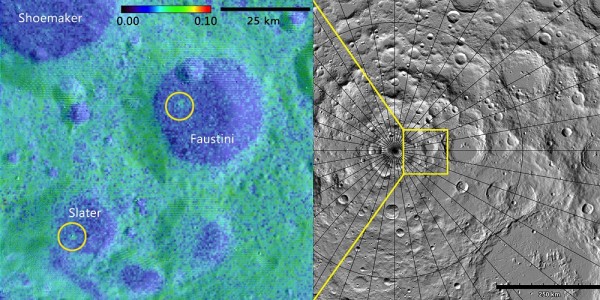Two New Craters Revealed on 'Dark Side of the Moon'
| Ana Verayo | | May 25, 2016 07:55 AM EDT |
(Photo : NASA GSFC/SwRI and NASA GSFC/ASU Jmoon) Using data from the LAMP instrument aboard the Lunar Reconnaissance Orbiter, a Southwest Research Institute-led team of scientists discovered two geologically young craters — one (right) 16 million, the other (left) between 75 and 420 million, years old — in the Moon’s darkest regions. One lies within Slater Crater, named for the late Dr. David C. Slater, a former SwRI space scientist who designed and built the LAMP instrument.
Scientists have confirmed evidence of two freshly made craters on the dark side of the moon. This new study reveals how these young craters on our natural satellite are aged between 16 million years old and 75 to 420 million years old.
Like Us on Facebook
These new findings by a team of researchers from the Southwest Research Institute, were obtained from data collected from the Lyman-Alpha Mapping Project (LAMP) instrument aboard the NASA Lunar Reconnaissance Orbiter (LRO).
This NASA probe utilizes ultraviolet wavelengths to map out lunar terrain where the team discovered two new sites that possessed brighter and rougher impacts, near the moon's southern polar region. The team also says that these craters are estimated to be several kilometers across that are produced by collisions from flying objects that smashed into the moon's surface during the early stages of the solar system's development.
These craters are also ideal specimens to study, in order to shed more light about the evolution of the solar system and the planets as well. According to senior scientist Kathleen Mandt from the Southwest Research Institute, these "young" impact craters are such an exciting discovery, where the ages of these geologically young impact craters along with their distinct characteristics can further help in the understanding of the solar system's history.
Apart from their age, the geological data from these craters can also provide crucial information about the frequency of these collisions during this time in the solar system. A young crater's surface contains rough rubble remnants and condensed dust that have been covered with darker dust from weathering in the course of millions of years.
Mandt explains that these two craters provide an incredible opportunity to investigate young craters that are hidden in the mysterious regions of the moon. This new technique is not only applicable to our moon but it can also be applied to other planetary bodies like Mercury, the dwarf planet Ceres and asteroid Vesta, which are both in the major asteroid belt between Mars and Jupiter.
This new study is published in the journal, Icarus.
Tagsmoon, two new craters moon, lunar craters, impact craters, craters moon, dark side of the moon, NASA
©2015 Chinatopix All rights reserved. Do not reproduce without permission
EDITOR'S PICKS
-

Did the Trump administration just announce plans for a trade war with ‘hostile’ China and Russia?
-

US Senate passes Taiwan travel bill slammed by China
-

As Yan Sihong’s family grieves, here are other Chinese students who went missing abroad. Some have never been found
-

Beijing blasts Western critics who ‘smear China’ with the term sharp power
-

China Envoy Seeks to Defuse Tensions With U.S. as a Trade War Brews
-

Singapore's Deputy PM Provides Bitcoin Vote of Confidence Amid China's Blanket Bans
-

China warns investors over risks in overseas virtual currency trading
-

Chinese government most trustworthy: survey
-

Kashima Antlers On Course For Back-To-Back Titles
MOST POPULAR
LATEST NEWS
Zhou Yongkang: China's Former Security Chief Sentenced to Life in Prison

China's former Chief of the Ministry of Public Security, Zhou Yongkang, has been given a life sentence after he was found guilty of abusing his office, bribery and deliberately ... Full Article
TRENDING STORY

China Pork Prices Expected to Stabilize As The Supplies Recover

Elephone P9000 Smartphone is now on Sale on Amazon India

There's a Big Chance Cliffhangers Won't Still Be Resolved When Grey's Anatomy Season 13 Returns

Supreme Court Ruled on Samsung vs Apple Dispute for Patent Infringement

Microsoft Surface Pro 5 Rumors and Release Date: What is the Latest?










